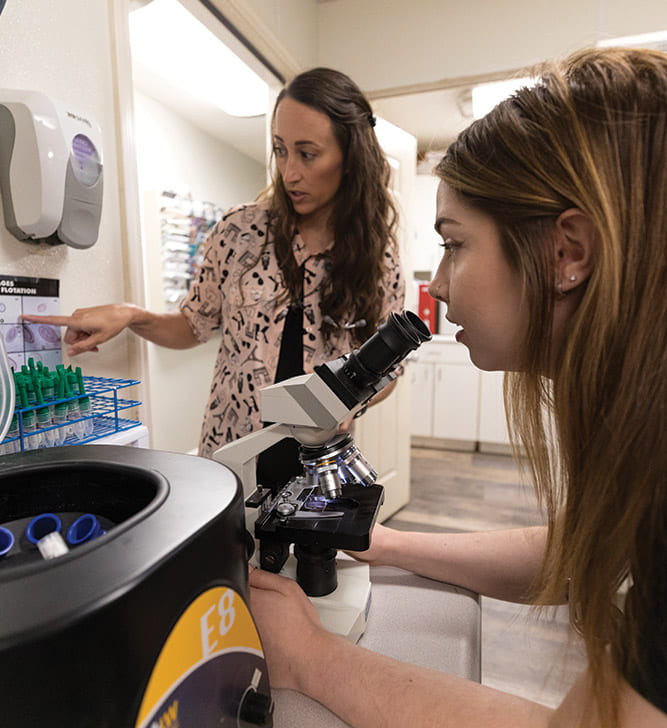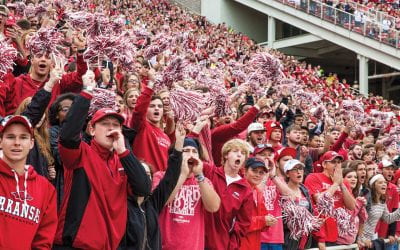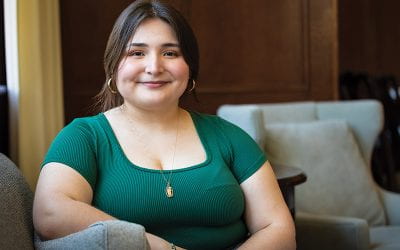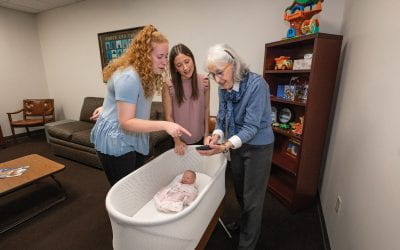Pandemic Pet Care
By Kendall Curlee

Photos by Russell Cothren
Stress, overtime, curbside care. Depression, burnout and turnover. COVID-19 packed a mighty wallop on all healthcare providers, including veterinarians and others who tend to our pets. Animal science majors Kayla DeSmet and Sabrina Cox labored in the trenches throughout the pandemic — DeSmet working at a hospital for small and exotic animals in Fayetteville, while Cox learned the ropes at a Tontitown clinic that cares for pets and livestock. For their honors thesis research, they decided to document COVID-19’s day-to-day and long-term impacts on the companion animal industry from 2020 to 2021.
“Everyone’s mental health was affected by this,” Cox said. “We figured, since there isn’t much reporting on what’s been going on in veterinary clinics, we might as well shed light on it ourselves.”
They worked with mentor Isabel Whitehead to develop a survey and reached out to 44 facilities in Northwest Arkansas. Cox focused on veterinary clinics while DeSmet recruited participants working at animal shelters, rescue organizations, animal daycares and boarding facilities. Ten facilities agreed to participate, and of these, 20 people completed the survey. Cox followed up on the survey by interviewing five veterinary staff.
The results are in, and the numbers are sobering. Cox found that 80% of the veterinary facilities surveyed experienced an increase in staffing shortages, while 100% reported an increased volume of daily appointments. 70% of respondents experienced depressive tendencies and 90% reported work-related burnout and stress.
DeSmet found that work conditions in pet care facilities changed throughout the pandemic, with an initial drop off in demand for services.

Kayla DeSmet checks the heart rate and heart and lung sounds of her dog Bandit.

Cox examines a bearded dragon’s fecal sample to check for intestinal parasites, assisted by Dr. Lindsey Erby
“I saw the number of animals and clientele both decreased for the year of 2020, and a few of the facilities, three out of 10, were forced to shut down — some of them moved to curbside and emergency services only,” DeSmet said. “People were fearful of getting COVID from their animals.” A preliminary study showed that dogs and cats can get COVID-19 but experienced few or no symptoms; “Humans are more likely to give COVID to pets, rather than vice versa,” she added.
As the lockdown persisted, pet adoptions went up, but in 2021, as constraints lifted and more people returned to work on site and travel away from home, “they saw a lot more surrender requests to get rid of animals, and they even coined the name ‘pandemic puppy,’” DeSmet said. “That was sad to find out.”
One of the biggest problems clinics faced was staffing shortages, forcing many to work overtime. DeSmet recalls that at one point, “We had eight staff members out with COVID, and we only had three people on the floor with an eight-doctor clinic. And generally, you try to have at least two assistants per doctor.”
Cox used the Warwick Edinburgh Mental Wellbeing Scale to measure stress and found that many reported that “they’re rarely feeling relaxed, and 90% barely have any energy to spare. A lot of people said that their overall mental health decreased 90%. Everyone reported an increase in anxiety. It affected everyone in the field.”
Burnout led to turnover and training new employees, which upped stress levels even more: “This is not an industry where you can just go in and pretend you know what you’re doing — things can go south really fast,” DeSmet said. “If you make an error, that could be fatal, unfortunately.”
Long-term, COVID-19’s impact on pet care is a mixed bag. Demand for services is up, and in an effort to retain staff, many facilities have improved working conditions. For example, an animal emergency clinic in Springdale has improved hiring and training processes, no longer requires overtime, and began offering benefits, which has had “a very positive impact on employee morale,” Cox said.
Everyone reported an increase in profits for their clinic, and the pet care e-commerce industry has exploded. For example, Chewy.com, which sells prescriptions online, had record-breaking sales in 2020, up 46%, with more than $1 billion in profits for merchandise shipped directly to people’s homes.
Based on their survey results, anti-anxiety meds for Fluffy and Spot may be among the products delivered to people’s doorsteps. “We found that 90% [of those surveyed] believe that there will be an increase in the number of pets that suffer from separation anxiety, once the pandemic ends, and about 50% somewhat agree or strongly agree that there will be an increase in separation anxiety in pet owners,” DeSmet said. On a bright note, “60% believe that the relationship between animal owners and pets has resulted in a stronger human-animal bond since the pandemic.”
Cox and DeSmet shared preliminary findings with the Northwest Arkansas Veterinary Medical Association in 2021 and will present their final conclusions to that group later this year. Both students are applying to veterinary schools.
Cox and DeSmet received Bumpers College Undergraduate Research Grants.

Sabrina Cox performs an otoscopic exam on her cat Fern
More Field Notes
Daylighting Hot Springs
When Zane Colvin moved from rural Wynne to bustling Hot Springs, he was wowed by the urban energy of his new home, but curious about the hot springs — where were they? Check out his bold proposal for Arkansas’ top tourist attraction.
Brand Fans
For her honors thesis, Madeline Braun explored how the Kansas City Chiefs and the Razorbacks cultivate identity loyalty within their own brands. To find the secret sauce, she distributed a survey asking both Chiefs and Razorbacks devotees to answer questions about their sense of pride and loyalty in their team.
Colorblind Quadrilles? A Closer Look at Bridgerton
For her honors thesis, senior political science major Daniella Ruiz Cantú knew that she wanted to combine her studies in both sociology and political science with her interest in film. She was confused why, despite numerous successful films featuring people of color front and center — like Coco and Crazy Rich Asians — she continued to encounter racism in the news and in person. After taking Lisa Corrigan’s honors colloquium in communications, she learned of one possible explanation: the reinforcement of the white gaze in media.
A New Angle On Climate Change
Dawson Oakley, a biological engineering senior, Honors College Fellow and hobbyist videographer with a passion for the outdoors and sustainability, decided to merge his interests by developing a video that raises awareness about climate change issues and showcases how engineering is being used to mitigate them.
Up All Night? Enter A.I.
Gabrielle Krupa, a senior communications sciences and disorders major, and Sutton Bauman, a senior communications sciences and disorders major with a background in human development, set out to explore how new technologies impact how parents bond with their newborn children.






